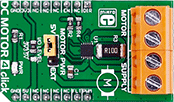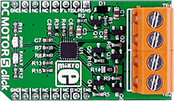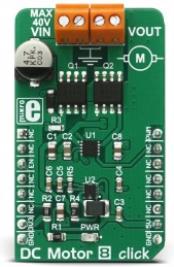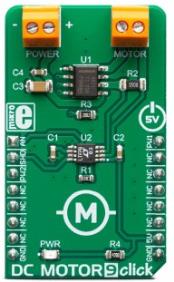|
|
| |
|
 | Search: |
|
|
|
|
|
 |

|
|
STSPIN250 click is a brushed DC motor driver with the current limiting and current sensing. It is based on the STSPIN250, a low voltage DC brushed motor driver. It is optimized for portable and low voltage applications, featuring the lowest standby current available on the market (max 80nA). Thanks to the low ON resistance of the MOSFETs used for its output stage, the STSPIN250 represents a highly efficient DC motor driver, with a very small (3x3mm QFN) form factor. The device implements a PWM current control with the fixed OFF time, along with a full set of protection features. STSPIN250 click can be used with the step motor voltage ranging from 1.8V to 10V, and current up to 2.6A.
STSPIN250 click is supported by a mikroSDK compliant library, which includes functions that simplify software development. This Click board™ comes as a fully tested product, ready to be used on a system equipped with the mikroBUS™ socket.
|
|
|
|
|
 |

|
|
DC MOTOR click is a DC motor driver board in the mikroBUS form factor. It features the DRV8833RTY H-Bridge motor driver, 74HC4053 multiplexer and two screw terminals. The 74HC4053 IC is incorporated into the design so that the motor can be run using only the one PWM line available on the mikroBUS socket. DC MOTOR click communicates with the target board via SELECT1, SELECT2 and nSLEEP control lines; PWM input line and nFAULT feedback line. The board is designed to use either a 3.3V or 5V power supply. It can be powered from the mikroBUS socket, or externally through the CN2 screw terminals (3-10V). It is limited to a 0.9A driving current and has a 0.22R current sense resistor. The motor is connected to the CN1 screw terminal. |
|
|
|
 |

|
|
DC MOTOR 2 click carries the TB6593FNG driver IC for direct current motors. With two pairs of screw terminals (power supply and outputs), the click board can drive motors with voltages from 2.5 to 13V (output current of up to 1.2 amps with peaks up to 3.2 amps). The PWM signal drives the motor while the IN1 and IN2 pins provide binary direction signals that set the direction of the motor (clockwise or counter clockwise), or apply stop or short brake functions. Stop mode cuts off the power supply so the motor continues spinning until it runs out of momentum. Short break brings it to an abrupt stop. |
|
|
|
 |

|
|
DC MOTOR 3 click is a mikroBUS™ add-on board with a Toshiba TB6549FG full-bridge driver for direct current motors. The IC is capable of outputting currents of up to 3.5 A with 30V, making it suitable for high-power motors.
Two pairs of screw terminals are positioned on the top of the board. One is for bringing an external power supply; the other is for connecting a motor.
TB6549FG has four operating modes: clockwise, counter-clockwise, short brake and stop. The operating mode is configured through IN1 and IN2 pins. A separately controlled standby mode is also available.
For safety, the TB6549FG IC incorporates overcurrent protetciont and a thermal shutdown circuit.
The click communicates with the target MCU through the mikroBUS™ PWM pin, with additional functionality provided by IN1, IN2 and SLP pins (in place of default mikroBUS™ AN, RST and CS pins). Designed to use a 3.3 power supply only. |
|
|
|
 |

|
|
DC MOTOR 4 click is capable of driving motors with a supply voltage from 4.5V to 36V. It carries the MAX14870 motor driver from Maxim Integrated.
The click is designed to run on either 3.3V or 5V power supply. DC MOTOR 4 click communicates with the target MCU over the following pins on the mikroBUS™ line: PWM, AN, CS, and INT. |
|
|
|
 |

|
|
DC MOTOR 5 click carries the DRV8701 brushed DC motor gate driver from Texas Instruments.
The click is designed to run on an external power supply. It communicates with the target MCU over the following pins on the mikroBUS™ line: AN, RST, CS, PWM, and INT. |
|
|
|
 |

|
|
DC MOTOR 7 click is a dual brushed DC motor driving Click board™, featuring the advanced PWM chopper-type integrated DC motor driver, labeled as TB67H400AFTG. This IC can drive two brushed DC motors independently, using a wide range of supply voltages, while delivering reasonably high current to the connected DC motors. This is possible due to the low resistance of the integrated H-Bridges. In addition to being able to drive two independent DC motors, it can be used in a so-called large mode to drive a single motor, utilizing both bridges in parallel. This effectively doubles the amount of current it can deliver to the DC motor.
The Click board™ is supported by the mikroSDK compliant library, which includes functions that simplify software development. The Click board™ comes as a fully tested product, ready to be used on a system equipped with mikroBUS™.
|
|
|
|
 |

|
|
DC Motor 8 click is a DC motor driver. It can drive simple DC motors with brushes, providing them with a significant amount of current and voltage up to 40V. The click has one control input, that uses the PWM signal from the host MCU. It uses the half-bridge topology to regulate the speed of the motor rotation, employs advanced dead-time circuitry that monitors the output stage, providing maximum switching efficiency and features an advanced technique to avoid shoot-through currents.
Features, such as high-efficiency factor, low overall power consumptions and complete isolation of the output stage, enable this device to be used in various battery operated handheld tools, fans and in general - whenever a powerful and reliable DC motor driver is required. |
|
|
|
 |

|
|
DC Motor 9 Click is a brushed DC motor driver with the current limiting and current sensing. It is based on the DRV8871, an integrated H-Bridge driver IC, optimized for motor driving applications. It can be operated by two logic signals, allowing to drive the connected motor in two different ways: it can use fixed logic levels for the direction control, or it can be controlled by a PWM signal, offering an additional speed control option. The DRV8871 also contains a set of protection features, offering a very high level of reliability. Besides driving capabilities, DC Motor 9 click can also sense current consumption at its output.
DC Motor 9 Click is supported by a mikroSDK compliant library, which includes functions that simplify software development. This Click board™ comes as a fully tested product, ready to be used on a system equipped with the mikroBUS™ socket.
|
|
|
|
 |
|
|

